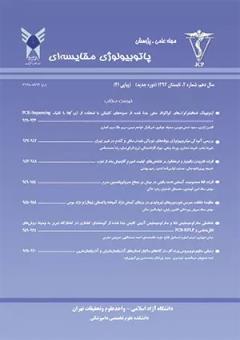مطالعه آزمایشگاهی آلودگی محیط و سطوح لوازم اتاق جراحی کلینیکهای دامپزشکی تهران به باکتری سودوموناس
محورهای موضوعی : پاتوبیولوژی مقایسه ای
مهبد کاظم عرب
1
,
حسام الدین حسین زاده
2
*
![]() ,
مجید محمد صادق
3
,
مجید محمد صادق
3
1 - گروه علوم درمانگاهی، واحد گرمسار، دانشگاه آزاد اسلامی، گرمسار، ایران
2 - گروه علوم درمانگاهی، واحد کرج، دانشگاه آاد اسلامی، کرج ، ایران
3 - گروه علوم درمانگاهی، واحد گرمسار، دانشگاه آاد اسلامی، گرمسار، ایران
کلید واژه: باکتری سودوموناس, آلودگی, محیط جراحی, عفونت بیمارستان,
چکیده مقاله :
عفونتهای بیمارستانی علاوه بر افزایش نرخ مرگ و میر میتوانند با افزایش مدت زمان بستری و در نتیجه افزایش هزینههای درمانی، تأثیر زیادی بر اقتصاد درمان داشته باشند. باکتری سودوموناس بدلیل سازگاری خوب با محیط و امکان رشد میتواند در مکانهای مختلف بیمارستانی، از اهمیت زیادی برخوردار است. در این مطالعه از ۳۹ کلینیک و ۱۱ بیمارستان مختلف ۲۰۰ نمونه با سوآپ استریل تهیه گردید و روی ۳ محیط کشت مختلف (مک کانکی آگار، ستریمید آگار و سودوموناس P آگار) کشت داده شدند. از هر مرکز درمانی دامپزشکی ۴ عدد نمونه اخذ شد که به ترتیب مربوط به میز جراحی، میز وسایل کار، زمین و سینک ظرفشویی بودند. نتایج نشان داد، در مجموع ۹ مرکز درمانی دامپزشکی آلوده به باکتری سودوموناس بودند که شامل ۴ کلینیک و ۵ بیمارستان بود. همهی میزهای جراحی در همه مراکز تمیز بودند ولی آلودگی در سه سطوح دیگر دیده شد. بعد از انجام ۱۲ تست مختلف بیوشیمیایی و تطبیق با رفرنس باکتری، در مجموع ۲ نمونه سودوموناس آئروژینوزا (۲۲/ ۲۲ درصد)، ۴ نمونه سودوموناس استیوتزری (۴۴/۴۴ درصد) و ۳ نمونه سودوموناس استیوتزری یا مندوسینا (۳۳/۳۳ درصد) تشخیص داده شدند. در مجموع بیمارستانها از کلینیکها آلوده تر بودند. با این وجود، پروتکلهای بهداشتی برای میز اتاق جراحی در تمامی مراکز درمانی دامپزشکی تهران (کلینیک و بیمارستان) صحیح می باشند ولیکن باید علاوه بر میزهای جراحی، به محیطها و سطوح دیگر توجه بیشتری شده و از مواد ضد عفونی کننده مناسب نیز استفاده شود تا از عفونت های احتمالی جلوگیری گردد.
Hospital-acquired infections (HAIs) caused by pathogenic bacteria are one of the important factors contributing to mortality in veterinary hospitals. Additionally, these infections can have a significant impact on healthcare economics by increasing hospitalization time and treatment costs. Among the causative factors of HAIs, Pseudomonas bacteria are of great importance due to their good adaptive abilities to the environment and their ability to be present in any part of the hospital. In this study, 200 samples were collected from 39 clinics and 11 different veterinary hospitals, and were cultured on three different media (MacConkey agar, Cetrimide agar, and Pseudomonas P agar). Four samples were taken from each veterinary medical center, surgical table, equipment table, floor, and sink, respectively. The results showed that 9 veterinary medical centers were infected with Pseudomonas bacteria, including 4 clinics and 5 hospitals. All surgical tables in all centers were clean but contamination was observed at the other three surfaces. After carrying out 12 different biochemical tests, a total of 2 samples of Pseudomonas aeruginosa (22.2%), 4 samples of Pseudomonas stutzeri (44.4%) and 3 samples of either Pseudomonas stutzeri or mendocina (33.3%) were identified. Overall, hospitals were more contaminated than clinics. However, disinfection protocols for surgical tables in all Tehran veterinary medical centers (clinics and hospitals) are correct but greater attention must be paid to other environments and surfaces and appropriate disinfectants should be used to prevent potential infections.
1. Stull JW, Weese JS. Hospital-associated infections in small animal practice. Veterinary Clinics: Small Animal Practice. 2015;45(2):217-33.
2. Benedict KM, Morley PS, Van Metre DC. Characteristics of biosecurity and infection control programs at veterinary teaching hospitals. Journal of the American Veterinary Medical Association. 2008;233(5):767-73.
3. Verdial C, Carneiro C, Machado I, Tavares L, Almeida V, Oliveira M, et al. Controlling bacteriological contamination of environmental surfaces at the biological isolation and containment unit of a
veterinary teaching hospital. Irish Veterinary Journal.2021;74:1-10.
4. Ruple‐Czerniak A, Aceto H, Bender J, Paradis M, Shaw S, Van Metre D, et al. Using syndromic surveillance to estimate baseline rates for healthcare‐associated infections in critical care units of small animal referral hospitals. Journal of veterinary internal medicine. 2013;27(6):1392-9.
5. Boerlin P, Eugster S, Gaschen F, Straub R, Schawalder P. Transmission of opportunistic pathogens in a veterinary teaching hospital. Veterinary Microbiology. 2001;82(4):347-59.
6. Sebola DC, Oguttu JW, Kock MM, Qekwana DN. Hospital-acquired and zoonotic bacteria from a veterinary hospital and their associated antimicrobial-susceptibility profiles: A systematic review. Frontiers in Veterinary Science. 2023;9:2065.
7. Day MJ, Breitschwerdt E, Cleaveland S, Karkare U, Khanna C, Kirpensteijn J, et al. Surveillance of zoonotic infectious disease transmitted by small companion animals. Emerging Infectious Diseases. 2012;18(12):e1.
8. Taylor LH, Latham SM, Woolhouse ME. Risk factors for human disease emergence. Philosophical Transactions of the Royal Society of London Series B: Biological Sciences. 2001;356(1411):983-9.
9. Sebola D, Eliasi UL, Oguttu JW, Qekwana DN. Antimicrobial resistance patterns of Pseudomonas aeruginosa isolated from canine clinical cases at a veterinary academic hospital in South Africa. Journal of

